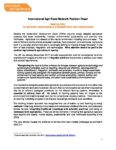UNEA4: Innovation for Sustainable Consumption and Production
Meeting the Sustainable Development Goals (SDGs) requires locally adapted agricultural practices that foster productivity, maintain environmental sustainability and promote rural livelihoods. Agriculture is a steward of the natural environment including land and water. The world’s farmers provide provide ecosystem services, food production, and livelihoods.
Agriculture work in a complex environment and is continually striving to improve through innovation in the form of best practices, integration, and technologies. More attention should be paid to the positive improvements agriculture is making.
The UN has already (December 2017) formally supported the need for convergence of all the available technologies and their use in integrated solutions that are able to address local needs and societal requirements.
“Recognizing the need to further enhance the linkages between agricultural technology and agroecological principles, such as recycling, resource use efficiency, reducing external inputs, diversification, integration, soil health and synergies, in order to design sustainable farming systems that strengthen the interactions between plants, animals, humans and the environment for food security and nutrition, enhance productivity, improve nutrition and conserve the natural resource base, and attain more sustainable and innovative food systems”.1
It is important to recognize sustainable agriculture as a process that evolves over time rather than a prescribed and static set of practices. As such, there is not one particular set of farming practices that fits all different ecological conditions nor the different farming systems. Innovation is essential to achieve them all. By default, all farming systems have an impact on the environment from traditional slash and burn to conventional cropping methods. The future lies in an evolving multiplicity of systems but that are increasingly tailored to local conditions.
The evolving broader approach has recognised the use of bottom up and “learning by doing” methods in training, focusing on the needs and preferences of different farmers, and particularly women farmers, integrating traditional knowledge with scientific practices, and taking on landscape-level approaches. These are all key elements in ensuring that agriculture supports food security and quality, market access, sustainability and rural livelihoods according to the SDGs.
This also directly impacts the resilience of farmers who have multiple challenges as outlined in SDG 2.4:
SDG 2.4: by 2030 ensure sustainable food production systems and implement resilient agricultural practices that increase productivity and production, that help maintain ecosystems, that strengthen capacity for adaptation to climate change, extreme weather, drought, flooding and other disasters, and that progressively improve land and soil quality.
To read in detail about the key areas that should be considered, consult the IAFN Position Paper on Innovation for Sustainable Consumption and Production:
-
IAFN – Sustainable Consumption and Production – Position Paper – 2019
Meeting the Sustainable Development Goals (SDGs) requires locally adapted agricultural practices that foster productivity, maintain environmental sustainability and promote rural livelihoods. Agriculture is a steward of the natural environment including land and water. The world’s farmers provide provide ecosystem services, food production, and livelihoods. Agriculture work in a complex environment and is continually striving to improve through innovation in the form of best practices, integration, and technologies. More attention should be paid to the positive improvements agriculture is making
Download


